


The case of rice-fish farmer Mang Isko from Dasmariņas, Cavite, Philippines
by Frank V. Fermin, Mary Ann P. Bimbao and Jens Peter Tang Dalsgaard
Household profile
Mang* Isko is a 66-year old farmer. Together with his wife, who is 60, they have eight children most of whom are grown-ups and living away from home. The only son is married and living with his wife and children near the farm of Mang Isko. This son helps Mang Isko in the day-to-day management of the farm. Two daughters are attending high school and still live at home. Two older daughters, who are working in Japan, send P4 000/month to support the education of their younger sisters.
Mang Isko's farm transect (lowland farm)
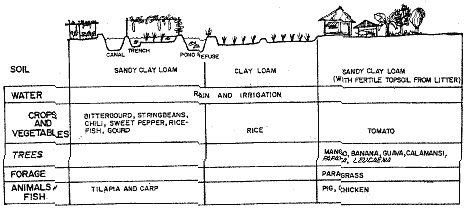
Mang Isko's on-farm material flows
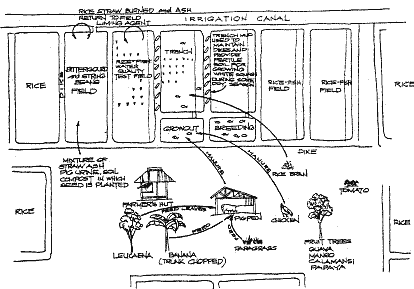
Farming systems
Mang Isko farms 2.3 ha of lowland with access to irrigation water from the National Irrigation Administration distribution system. Two rice crops are grown in 1.44 ha. Half a hectare is devoted to rice-fish culture. In some years, gourd is planted on the rice-fish dikes after the second rice harvest. Other vegetables occupy 0.14 ha of the farm where bittergourds are planted in the dry season and relayed with stringbeans in the wet season. The remaining 0.2 ha houses 1 pig in a 15 x 12 m shed and the rest of the area is grown to fruit and fodder trees and grasses.
Rice-fish subsystem
The 0.5 ha rice-fish system is composed of eight individual fields with side trenches. Two rice-fish plots have adjacent pond refuges in addition to the trenches. One rice-fish plot has an adjacent pond which is managed as a breeding pond. Mang Isko practices rice-fish culture in both wet and dry seasons and harvests two crops of rice and fish in a single year. However, when he plants gourd on the rice-fish dikes after the second rice-fish crop, he does not have a dry season rice-fish activity. In such occasions, the fields are drained and the fish are kept for growout in the pond refuges.
Combining fish with rice has doubled Mang Isko's rice yields in some cropping seasons. He attributes the increase in yield to these factors:
- Rice plants uprooted when digging the trenches are used to patch up vacant spaces in the ricefield where transplanted rice has not grown.
- The beneficial effect of fish on rice growth is manifested in the increased filleting of rice plants and the uprooting of young weeds when the fish (carp) stir up the bottom of the field in their search for food.
- The introduction of fish has meant that Mang Isko spends more time in his farm. Thus, he can spot and remedy problems immediately. In his own words, he has become «a better farm manager.»
- Fish eat rice pests, thus rice yields are less threatened by pest damage.
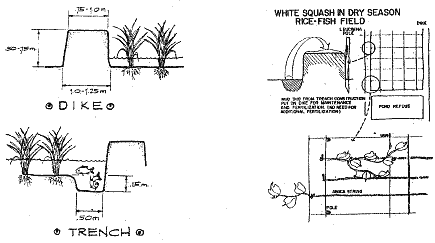
Rice-fish culture practices
1. Land preparation, construction and maintenance
- Dike construction is labour-demanding. According to Mang Isko, it has been the biggest obstacle to rice-fish adoption. Collapse must be avoided and water seepage and overflow must be minimized in large dikes. They must be cleaned and weeded regularly to prevent damage by rodents.
- The trenches are dug one month after rice transplanting. The dugout mud is placed on the dikes for maintenance and is the source of fertile soil for the subsequent cultivation of gourd. Also, at this stage, the dugout soils are more compact as they have been soaked with water and this makes dike construction easier.
- Mang Isko uses one of the eight rice-fish fields with the highest elevation, as a test-field for monitoring water quality that comes in from the irrigation canal. This is to ensure that contaminated water due to pesticide applications of neighbouring farms do not get into his rice-fish fields. The irrigation water is let through this field first and any adverse effect on the fish is observed. The field is only lightly stocked (50 fish/800 mē).
Mang Isko's monthly cash flows, showing cash expenses (cash outflows) and income earned (cash inflows) in one-year operation of vegetable production, rice monoculture and rice-fish culture
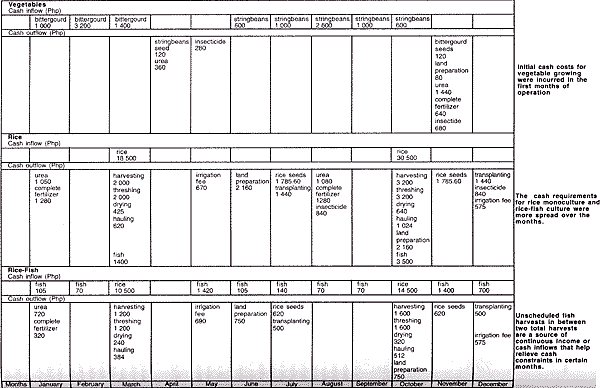
Mang Isko's calendar of farm activities
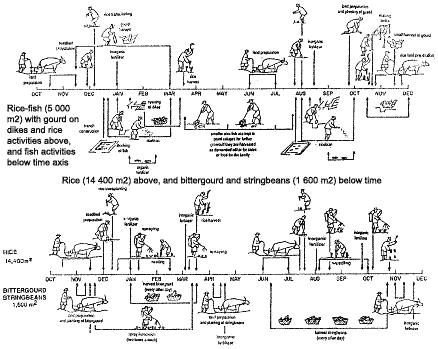
2. Rice transplanting and management
- Rice is transplanted 10-12 days after sowing in seedbed.
- Around one month after transplanting, three rows of rice, occupying about 60 cm, are removed for the purpose of trench construction. The uprooted rice plants are used to replace transplanted rice that has not grown.
- According to Mang Isko, IR 64/74/42 varieties are not suitable for rice-fish as they easily lodge (i.e. stems bend and fold over).
- He will try to use an early-maturing rice variety for the dry season to avoid any critical water shortage. At present, he uses a 90-day maturing variety for both seasons.
Mang Isko's monthly cash flows of all farm operations
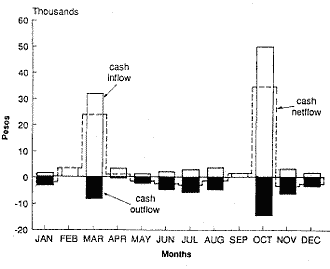
3. Fish stocking and management
- Mang Isko keeps a separate breeding pond. Having one ensures fingerling supply. Moreover, he could stock large fingerlings which can be harvested as table-size fish immediately before rice harvest. However, without proper broodstock management, he had an inbred population after three years as reflected by stunted fish growth. After five years, he did not keep any broodstock.
- Fingerlings are stocked in the pond refuges immediately after rice transplanting. After one week, the dikes connecting the pond refuge and the rice-fish plots are broken to let the fish in the rice-fish plots. (Stocking density: 1 tilapia/m2 and 1 carp/5 mē.)
- The fingerlings/fish are graded into four classes when transferred from the breeding pond to refuge ponds and rice-fish fields: Class I, 25 pieces/kg; Class II, 35 pieces/kg; Class III, 40 pieces/kg; and Class IV, 50 pieces/kg. This is done in order to avoid cannibalism and competition that would otherwise lead to large fish stunting the growth of small ones.
- One week after trench is constructed, it is filled with water and fish are stocked.
4. Fertilizing and feeding
- Rice straws from the previous crop are burnt and the ashes are returned to the fields for liming.
- Pig manure is thrown directly into the ponds or left by the inlet for water to carry/wash it into the rice-fish fields.
- Fish feed on fallen rice flowers. Mang Isko believes that this has a purifying effect which counteracts the perceived off-flavour taste of tilapia due to the presence of pig manure in the system.
- Rice bran is given one week after stocking in refuge ponds and trenches until two weeks before fish harvest. This is done twice a week or when required as may be signaled by the inactive behaviour of fish or its stunted growth.
- Three weeks after transplanting, 100 kg urea and 50 kg complete fertilizer are applied to the ricefields.
5. Pest and disease management
- Carp eat hatched golden snail eggs which drop into the water; tilapias feed on insects.
- Mang Isko submerges the rice crop for 3 hours when insects become a problem. The fish then feed directly on insects on the plants as well as those trapped on the water surface. This practice is only carried out when the rice is 1-2 months old.
- Mang Isko reports that a neighbour of his uses Gliricidia (kakawate, a nitrogen-fixing tree) as an insect repellant. In his first year of rice-fish, he placed Gliricidia branches approximately 1 m long at 2 m intervals around the edge of the field at the booting stage of rice, i.e. seven weeks after transplanting. He has now planted Gliricidia trees around the field as a means of biological pest control.
- When constructing the dikes, a layer of plastic is placed on the inside of each dike. Rats find it slippery and difficult to penetrate the dikes with plastic lining.
6. Harvesting
- The fish are harvested by draining the field 3 days before rice harvest. The water level in the refuge is lowered to several centimetres and the fish are caught by hand.
- Table-size fish are sold. Fingerlings are kept for the next crop. Fish, which sizes are in-between, are returned to the pond refuge for further growout. They are consumed at home or sold, as a source of continuous income.
Monthly cash flows
- There were 5 months in the year where cash obtained from the sale of rice, fish and vegetables was greater than the cash spent on farm operations.
- The months in between rice and fish harvests were the period when cash deficit was greatest.
- Although there were sales received from vegetables before the rice and fish harvests, these were not enough to cover the large expenditures on inputs, particularly inorganic fertilizers.
Conclusion
As a whole, farming for Mang Isko was profitable. At the end of the year, he earned P45 233.80. He used this money primarily to sustain his wife and two children. A part of this was spent in upgrading his living condition, that is, he was able to improve his house and to purchase a refrigerator and a television set.
Issues for further consideration
The location of this single-household case study in Cavite, south of Manila, is classified as peri-urban, which has relevance on opportunities for sale of farm products. The area has undergone industrialization in the last decade and most of the farms have been bought up and the aggregated land converted to housing estates or factory installations.
Nevertheless, the case study illustrates the way the adoption of a rice-fish component has allowed further diversification on the farm. This is also based on labour availability and market opportunities for the new products. Part-time off-farm employment played an important role in household income for farmers in the area.
The farmer learned about integration opportunities from interactions with IIRR field staff. As most farmers are leaseholders, they need permission from their (usually absentee) landowners to modify the farm, i.e. dig deeper trenches and fish refuges, or even fishponds. This permission is often not granted. |
* «Mang» is a respectful address for an elder in the Philippines











